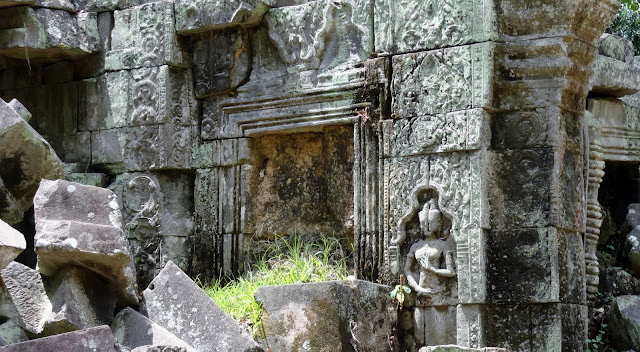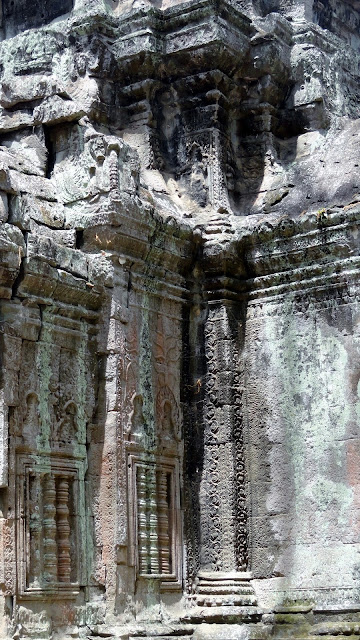We left Angkor Thom and continued on to... Guess what? Another old and decaying temple! This temple had a somewhat modern "claim to fame" though as it was used as a location in the film "Lara Croft: Tomb Raider", starring Angelina Jolie, the home-wrecker everyone loves to hate.
Ta Prohm, one of the most visited sites in the Angkor area, was built in the late 12th and early 13th centuries and is located about 1 kilometer East of Angkor Thom. The temple was founded by King Jayavarman VII and was used as a Buddhist monastery and university. After the fall of the Khmer Empire in the 17th century, Ta Prohm was neglected and then finally abandoned to the jungle. After its re-discovery and during the effort to restore the temples of Angkor (in the early 21st century), it was decided that the temple would be left as it had been found - almost at one with the Cambodian jungle. Although conservation and restoration projects are on-going (the most current one is being led by India), the scope of work has been limited to include only the most basic of maintenance to the ruins so as to permit access to visitors.
So, what does basic maintenance include? Based on what we saw, not much and certainly nothing that involved tree trimming or removal. The tree in the photo below is growing on top of what is left of the roof of the building, not behind it.
The view from the rear.
The trees growing on top of and out of the ruins at Ta Prohm are really the most distinctive feature of this temple. Sopheap told us what species of trees these were but I forgot. He said the seeds were most likely carried and then dropped by birds on the ruins. Left alone for many centuries, the trees grew to their current state and their massive roots have literally split the temple into pieces.
It was rather sad to see the state of the site knowing that, at one time, it was very magnificent. Sopheap said it is thought that it took about 30 years to build Ta Prohm and it would take over 100 years to reconstruct and restore the temple back to its original state.
A few areas of the temple that weren't destroyed had interesting carvings, although certainly not as extensive and as detailed as those we had seen at Angkors Wat and Thom .

There was a small chamber inside the temple and, if you pounded on your chest (a la King Kong), the echo reverberated throughout the room. It didn't "work" if you pounded anywhere else on your body or on anything else. Just your chest.


This area near the front entrance of the temple was undergoing restoration work.
The photos below are of areas that had been restored.
The quick fix in the photo below made me a little nervous. Kind of like a band-aid on a wound to the jugular vein.
This was the staging area for the restoration project. It looked like there was a plan (and a complicated one at that) for putting this puzzle back together.

Sophead said that because the damage was so extensive, at this time, the restoration work only involved getting the pieces put back together again and the temple reconstructed. Any detailed carving work would be done *later* (see my note above on the estimated completion date of the restoration).
An afternoon siesta.
Sophead took us to a restaurant for lunch and then back to the hotel for us to have our own sietsa during the hottest part of the day.
Have a great Sunday!





































No comments:
Post a Comment